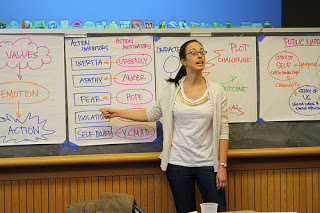- Public Policy
- Leadership
- Funding
- News & Events
- About the Center
Back to Top Nav
Back to Top Nav
Back to Top Nav
Back to Top Nav

Kate Hilton ’99, consultant at the Hauser Center for Nonprofit Organizations at Harvard University, led this session entitled “How Do Leaders Motivate Others to Join Them In Action: The Art of Public Narrative.” Kate engaged the group by telling her own story of coming to Dartmouth and later traveling across the country in a Volkswagen van to examine community-based conservation projects. She used this story to introduce the three types of stories: a story of the self (who am I, what is my background, where do I come from, and a call to leadership), the story of us (how do we work in a community, why and how do we all affect each other, shared values and experiences), and the story of now (why is an issue pressing, important, why should we get involved, and what our strategy and action will be). The linkers between these three stories are purpose, urgency, and community. Kate stressed the need to have a specific image related to your own story so that the audience will remember it, and not only hear your words, but also feel and imagine them. Through this method, you can control your own story because if you do not tell your own story, then someone else will tell it for you and you will be lost.
We then broke into small groups and each gave a try at telling a story using Hilton’s method. Even after just the beginning of the presentation, students began to see a difference in how they told stories and captured attention. Said Dylan Payne ’13, who spoke about tutoring and working towards better teaching and education, “I was more focused in what I said and could tell that the others listening to me were not simply hearing me, but were rather connecting with me.” In addition, because the MLDP program has only just started this term, breaking into small groups and telling personal stories gave the participants a chance to get to know each other much better. Following this, Hilton invited Patricia de Lucio ’12 up to share her story about her involvement with the Book Buddies program and she invited everyone to give back and make a difference in the lives of others. Hilton urged the group that when asking others to join you, one must be specific and give a clear path. For example, “I’d like you all to join me here at this time do this.”
Hilton then showed a quick presentation on body language, which led to a rousing discussion about knowing your audience and having the ability to change what you’re doing on a moments notice if your audience is not captivated and at attention. Next, Hilton showed clips from Barack Obama’s 2004 Keynote Speech at the Democratic National Convention. The group then discussed what Obama does so well as a speaker, specifically not speaking much about oneself, but rather connecting it to a part of a larger movement and progressing from a story of self, to a story of us, and finally to a story of now. Obama clearly motivated the audience by painting a picture and laying out a strategy.
The small groups met once again and using the new techniques learned from the Obama speech and non-verbal expression presentation, improved their stories from before and gave feedback to each other. Hilton ended the session by thanking the group for its attention, enthusiasm, and participation.
-- Sam Lewis '13